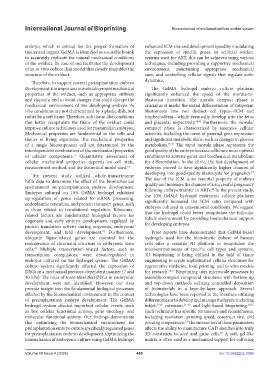Page 463 - IJB-10-4
P. 463
International Journal of Bioprinting Biomechanical mimic-based artificial oviduct system
embryo, which is critical for the proper formation of enhanced ICM size and development speed by modulating
tissues and organs. GelMA is identified as a suitable bioink the expression of specific genes. In artificial oviduct
to accurately replicate the natural mechanical conditions systems used for ART, this can be achieved using various
of the oviduct. Its ease of use facilitates the development techniques, including providing a supportive mechanical
of an in vitro culture dish model that closely resembles the environment, maintaining appropriate mechanical
structure of the oviduct. cues, and controlling cellular signals that regulate actin
Therefore, to support normal preimplantation embryo dynamics.
development, it is important to maintain proper mechanical The GelMA hydrogel embryo culture platform
properties of the oviduct, such as appropriate stiffness significantly enhanced the speed of the morula-to-
and viscosity, and to avoid changes that could disrupt the blastocyst transition. The morula compact phase is
mechanical environment of the developing embryo. In crucial as it marks the initial differentiation of totipotent
vivo conditions are not characterized by a plastic dish, but blastomeres into two distinct cell types—ICM and
rather by a soft tissue. Therefore, soft tissue-like conditions trophectoderm—which eventually develop into the fetus
that better recapitulate the tissue of the oviduct could and placenta, respectively. 44,45 Furthermore, the morula/
improve culture techniques used for mammalian embryos. compact phase is characterized by intensive cellular
Mechanical properties are fundamental to the cells and activities, including the onset of paternal gene expression
tissues of living organisms. The mechanical properties and significant metabolic shifts, such as changes in glucose
of a single biocomponent cell are determined by the metabolism. 45,46 The rapid morula phase represents the
interdependent combination of the mechanical properties good quality of the embryo because cells have more optimal
of cellular components. Quantitative assessment of conditions to activate genes and biochemical metabolism
17
cellular mechanical properties depends on cell state, for differentiation. In the clinic, the fast development of
measurement method, and the theoretical model used. 16 embryos proved to have significantly higher chances of
developing into good-quality blastocysts for pregnancy.
47
The present study utilized whole-transcriptome
NGS data to determine the effect of the biomechanical The size of the ICM is an essential property of embryo
quality and increases the chances of a successful pregnancy
environment on preimplantation embryo development. following embryo transfer in ARTs. In the present study,
48
Embryos cultured on 10% GelMA hydrogel exhibited the 10% GelMA hydrogel embryonic culture platform
up-regulation of genes related to mRNA processing, significantly increased the ICM ratio compared with
endoplasmic reticulum, and protein transport genes, such embryos cultured in conventional conditions. We suggest
as those related to translational regulation. Ribosome- that the hydrogel could better recapitulate the follicular
related factors are fundamental biological factors for tubule environment by providing biomechanical support
oogenesis and early embryo development, regulated by for developing embryos.
protein translation activity during oogenesis, embryonic
development, and fetal development. Furthermore, Prior reports have demonstrated that GelMA-based
42
ubiquitin ligase-related genes are essential for the hydrogels used for the biomimetic culture of human
maintenance of chromatin structure in embryonic stem cells offer a versatile 3D platform to recapitulate the
cells. Multiple transcription-related factors, such as microenvironments of specific cell types and systems.
43
transcription coregulators, were down-regulated in 3D bioprinting is being utilized in the field of tissue
embryos cultured on the hydrogel system. The GelMA engineering to create sophisticated cellular structures for
culture system significantly affected the expression of regenerative medicine, food printing, and in vitro models
DEGs in a mechanical pressure-dependent manner (7 and for research. 20,22 Bioprinting uses microscale processes to
10 kPa). The roles of some identified DEGs in embryonic assemble complex compound structures with bottom-up
development were not identified. However, our data and top-down methods utilizing controlled deposition
provide insight into the fundamental biological processes of biomaterials in a layer-by-layer approach. Several
affected by the biomechanical environment in the context technologies have been reported in the literature utilizing
of preimplantation embryo development. The GelMA different means to develop and manage the layers, including
hydrogel system affected important cellular events, such inkjet, 19,20 extrusion, 21–23 and light-based bioprinting. 24,25
as live cellular functional activity, gene oncology, and Each technique has specific parameters and requirements,
molecular functional activity. Our findings demonstrate including resolution, printing speed, construct size, and
that optimizing the biomechanical environment for printing temperature. The interaction of these parameters
23
preimplantation embryo culture specifically regulated genes affects the ability to manufacture CAD sketches into truly
for preimplantation embryo development. Optimizing the 3D constructs to seed and grow cells. A soft, gel-like
20
biomechanics of embryonic culture using GelMA hydrogel matrix is often used as a mechanical support for culturing
Volume 10 Issue 4 (2024) 455 doi: 10.36922/ijb.3346

